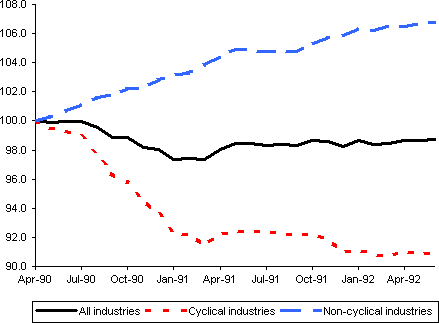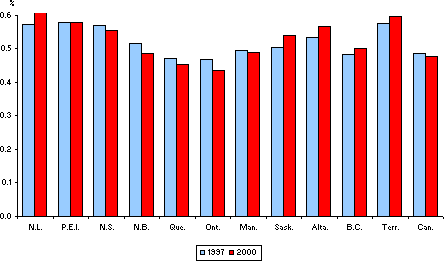Common menu bar links
Are some regions more sensitive to business cycles?
Archived Content
Information identified as archived is provided for reference, research or recordkeeping purposes. It is not subject to the Government of Canada Web Standards and has not been altered or updated since it was archived. Please "contact us" to request a format other than those available.
Structural differences in provincial and territorial economies
by Mehrzad Salem
The industrial makeup of Canada’s regional economies is so diverse that most changes in the general economic environment - the rising value of the Canadian dollar, for instance - almost always have sharply differential impacts on provincial and territorial economies. This article explores how the industrial structure of the provinces and territories renders some of them more, and others less, sensitive to business cycles.
This study uses the last recession in Canada (1990 to 1992) to identify industries that tend to amplify a downturn, and those that temper its impact on a province or territory. Next, it examines the industrial structure of the provinces and territories to identify where cyclical industries are over-represented and which jurisdictions tend to depend more on non-cyclical industries that have secular growth paths.
The analysis suggests that regions in which a high proportion of gross domestic product (GDP) originates from non-cyclical industries will be less affected by a general economic downturn, whereas a province with a high representation of cyclical industries will be impacted more adversely.
Recent data from the Provincial Economic Accounts suggest that, between 1997 and 2000, some provinces (Quebec, Ontario, Nova Scotia and New Brunswick) have seen an increasing share of their provincial GDP coming from cyclical industries, despite the fact that Ontario and Quebec already have the highest proportion of cyclical industries in Canada.
In contrast, jurisdictions that were less dependent on cyclical industries became even less cyclical during this period. These included Newfoundland and Labrador, Saskatchewan, Alberta, British Columbia and the territories.
The last recession in Canada is widely cited as the period between the second quarter of 1990 and the third quarter of 1992, inclusive. Chart 1 depicts the trend of national monthly real GDP, with April 1990=100. This study used a detailed breakdown of real GDP by industry that identifies more than 100 industries to analyse and compare the behaviour of each industry and the aggregate total over this cycle. For simplicity, industries are divided into cyclical and non-cyclical, to the exclusion of marginal or ambivalent cases. Specifically, an industry meets the criterion if its real GDP contracts more than the economy for at least one quarter over the cycle. If an industry’s trend lies below the aggregate for three consecutive months, it is considered cyclical; otherwise it is not.
Chart 1: GDP trend of cyclical and non-cyclical industries during the 1990-1992 recession

It is important to do this examination at a fairly detailed level (using a 110 industry breakdown) because industries that are similar in many respects may behave differently over a business cycle. For instance, manufacturing industries are typically very cyclical. But a look at individual industries reveals important differences in how they are affected by a downturn. While most manufacturing industries contracted more than the economy as a whole during the last cyclical downturn, this was not the case for the food manufacturing industry, nor for the computer and electronic product manufacturing industry. Both continued to expand after the economy entered the downturn, and registered solid growth over the entire cycle. The computer and electronic industry was in the midst of a phenomenal technological innovation boom that may have offset recessionary influences of the broader economy1. Both industries are classified as non-cyclical, based on the above criterion.
The first step was to designate for this analysis those industries that tend to make a province’s economy more prone to a downturn, and those that will likely moderate the impact of future business cycles on the province or territory. Once these industries were identified, the study measured their dominance in each provincial or territorial economy according to the industry group’s share of the GDP of the province or territory in 1997 and in 2000.
If non-cyclical industries become more dominant in a province’s economy, they would tend to make it more resistant to sharp declines in future business cycles. If cyclical industries occupy a larger share of a province’s GDP, they would have the opposite effect.2
Table 1 shows how industries making up the national economy have been split into two groups based on the above analysis. In Chart 1, the total real GDP of each group is contrasted with the economy (marked All industries) as a whole over the 1990-92 recession. While the economy experienced a 2.7% pullback at the bottom of this cycle in early 1991, non-cyclical industries as a group expanded by about 4%, while cyclical industries suffered a contraction of about 8%.
| Cyclical industries | Non-cyclical industries |
|---|---|
|
|
| 1 | Except food manufacturing and computer and electronic product manufacturing that are listed as non-cyclical industries |
| 2 | Except pipeline transport |
As the cycle came to an end in September 1992, the two groups had diverged further, separated by about 15 percentage points. What this suggests is that a province or territory whose domestic economy is more based on non-cyclical industries is less likely to experience a sharp contraction in a future business cycle, all else the same. How a province or territory will fare in a future business cycle will depend critically on the proportion of its economy’s GDP coming from cyclical rather than from non-cyclical industries.
This study analysed data from Provincial Economic Accounts to show the proportion of GDP coming from noncyclical industries between 1997 and 2000, the last year this detail is available3. Using this data, Chart 2 shows how much of the GDP of each province or territory comes from non-cyclical industries that are likely to grow during a cycle, as suggested by Chart 1. It also shows how the structure of provincial economies changed between 1997 and 2000.
Chart 2: Provinces’ and territories’ reliance on non-cyclical industries

Less than one-half of the GDP of Quebec and Ontario originates from non-cyclical industries. In contrast, all other provinces and territories are more reliant on non-cyclical industries than the national average. In Ontario, Quebec, New Brunswick and Manitoba - provinces where more than one-half of the GDP originates from cyclical industries - manufacturing is a significant part of the provincial economy. In Ontario and Quebec, more than 20% of GDP comes from manufacturing industries that were classified as cyclical because they under-performed the overall economy for at least one quarter during the 1990-92 recession.
Between 1997 and 2000, provinces in western Canada and the territories became less dependent on cyclical industries. New Brunswick and Nova Scotia followed an opposite trend, as did Quebec and Ontario. Newfoundland and Labrador’s economy became considerably more non-cyclical as the Hibernia offshore oil project came on stream and made the industry the largest single source of the province’s GDP in 2000, accounting for more than 15%. While the oil and gas industry is well known for its exploration cycles, the extraction industry tends not to follow broad-based business cycles in Canada.
By far the most dramatic structural shift occurred in Newfoundland and Labrador. There, the share of oil and gas extraction in the province’s GDP rose from a fraction of 1% in 1997 to more than 15% in 2000. While this certainly bodes well for the province should the economy encounter a downturn, it was partially offset by declines in the share of GDP of two important non-cyclical industries: finance, insurance and real estate (-3.6%) and public education (-2.0%).
The industrial structure of Prince Edward Island’s economy did not change greatly. Most noticeable was a 3.5% rise in the share of food manufacturing - a non-cyclical industry - in the province’s GDP.
Nova Scotia’s economy became slightly more cyclical because the share of its finance industry declined, while at the same time, it saw expansions in several manufacturing industries, such as paper, petroleum and coal products and rubber and plastic product manufacturing. This occurred despite a 2.8% increase in the share of GDP held by the non-cyclical oil and gas extraction industry.
New Brunswick experienced a similar trend. There, cyclical industries such as construction, paper manufacturing, and petroleum and coal products, as well as administrative and support services industries, occupied larger shares of the province’s GDP, while many of its non-cyclical industries showed declining shares.
Quebec and Ontario, the provinces with the most cyclical economies, saw more of their GDP coming from cyclical industries in both manufacturing and services. In Ontario, transportation equipment, fabricated metal and machinery manufacturing increased their share of the provincial economy. In addition, professional, scientific and technical services - a cyclical service industry - increased its share of Ontario’s GDP to 5%, rivalling the province’s retail trade industry in terms of size.
In Quebec, an increasing share of GDP came from cyclical industries in manufacturing, and professional, scientific and technical services and administrative and support services.
In Manitoba, growing shares in a number of cyclical industries were offset by growing shares in a number of non-cyclical industries, as well as contractions in machinery manufacturing and truck transportation, both cyclical industries. The province’s structure did not change significantly between 1997 and 2000. Cyclical industries accounted for about 51% of its GDP, about the same as the national average (52%) in 2000.
Saskatchewan, Alberta and British Columbia became substantially more non-cyclical. The change was dramatic in Saskatchewan and Alberta. In Saskatchewan, oil and gas extraction increased its share of provincial GDP by 5.7 percentage points, while in Alberta this industry increased its share by 7.4 percentage points.
In Saskatchewan, the shares of mining and construction declined, as did shares of cyclical services industries, such as publishing, professional, scientific and technical services and administrative and support services.
Alberta’s economy became considerably more non-cyclical because of a 7.4 percentage point increase in oil and gas extraction’s share of GDP. This was helped by declining shares in cyclical industries, such as wholesale and retail trade and truck transportation.
British Columbia’s economy also became more non-cyclical. However, oil and gas extraction played a more modest role, rising only 2.2 percentage points in the province’s GDP. Increasing shares for electric power generation, computer and electronic product manufacturing, and significantly lower shares for forestry and logging and construction, were important factors.
The economies of the territories, combined for this analysis, also became more non-cyclical, principally because an increasing share of their GDP came from oil and gas extraction. This was partly offset by a higher GDP share held by mining.

